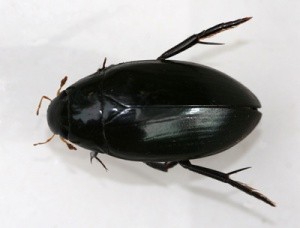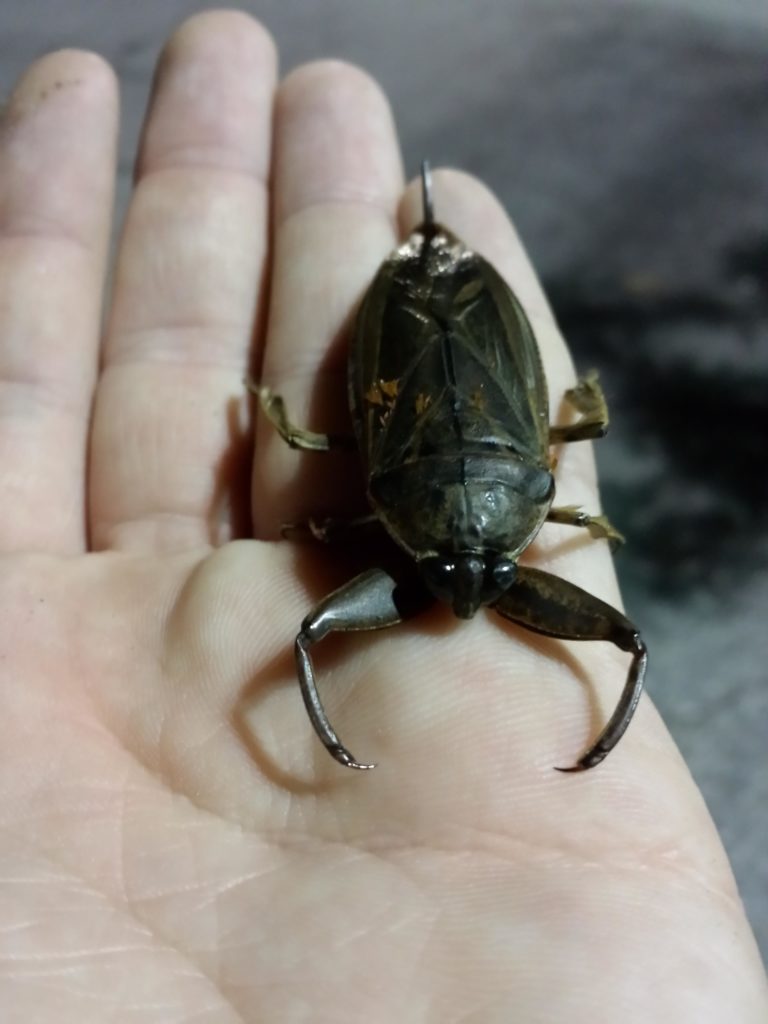Water Beetle refers to any beetle that is adapted to live in water at any point in its entire life cycle. It is an aquatic insect.
They are generally found in the lakes, ponds and marshes. Many water beetles are great fliers. They quickly colonise new ponds, and also move between ponds and other freshwaters during the year.
But not all beetles are fast movers. Some can’t fly at all, or only when its unusually warm, so can’t easily move from one pond to another. These species are often some of the most endangered because if the place they are living becomes in some way unsuitable they can’t move to a new home.
They weigh up to 70-100 g and they usually eat dead decaying aquatic plants, small fishes, tadpoles, aquatic insects, and snails. In the larvae stage, they usually feed upon the tadpoles and small fishes in their habitat.
The water beetles first paralyze their prey. It liquifies the body of the prey so the hunter can suck up a little repast.
Water beetles are attracted to different sources of light.

Water Beetles life stages
Eggs: The eggs of giant water beetles are about 5 mm long and deep yellow in colour . Female giant water beetles lay eggs in enclosed capsules .They are made from silk . Females produce silk from accessory glands located in spinnerets on the underside tips of their abdomens.
The eggs are congregated together in the silk enclosure and are deposited on floating debris in freshwater bodies. Composed of two layers, one layer of silk is attached to the floating substrate and one layer protects the eggs.
The egg case facilitates a transfer of oxygen to the eggs and to the young larvae as they hatch . While the eggs develop, the mast ensures the case stays afloat by keeping it oriented upwards. It also keeps the case in a position to receive optimal air supply within them.
Larvae: The immature beetles spend their time living in bodies of fresh water. Immature larvae can walk along the bottom of a pond or even out in the open air. Larvae breathe air through a tracheal system and must surface occasionally to refresh their air supply before going back underwater.
Larvae possess mandibulate mouthparts that are slightly different in size and shape and come together in a motion similar to scissors. This makes it difficult for actual chewing to occur, so the larvae can only bite, cut, or grab prey.
Beetle larvae are a light yellowish-brown in the inside and a darker brown on the outside. Two prominent lines run on either side of larvae down the length of the thorax to the tip of the abdomen. Larvae can swim using either their bodies or prolegs.
Pupae: As the larvae develop, they reach the pupal stage where they will remain until they molt into an adult. Larvae have aged enough to pupate once their color becomes a uniform dark brown on their dorsal and ventral sides. The larvae will then climb out of the body of water they have developed in and look for a place to bury themselves.
Here they will dig a pupal cell and will pupate. The larvae typically travel between two and 10 feet from the water’s edge to dig their pupal cell. The larvae prefer soil consistency that is dense clay with a high moisture content but will dig in sand if it is the only substrate available.
The larvae dig the pupal chamber with their mandibles, which takes them between 36 and 48 hours to excavate. They use a rotating motion to scoop the sediment until they have a semi-circular hole that is about three inches deep.
The larvae then insert themselves into the pupal cell, and pupate. Pupal development usually takes up to 10 days before adult emergence. During molting, the pupae resemble grubs, and are fleshy white with dark eyes .
Adults: Adults can be identified by their body shape and size. These beetles have a characteristic elongated and narrow body uncommon to other species. The largest beetle in the genus, water beetles usually grows up to 40 mm
Water Beetle Food Habits
Specific species of water beetles are omnivores. They feed on plants as well as on animals. Other beetles feed only on certain plants. Longhorn beetles, for example, feed only on a single plant. Carnivorous beetles feed on earthworms, snails and sometimes even tadpoles. The primary food source, however, is the decaying plants and animals.
Thus, depending on the diet type water beetles are predators, scavengers, or herbivores. Herbivores consume plant stalks, leaves, and algae. The predator beetles eat tadpoles, worms, and smaller fishes. Scavenger water beetles feed on dead organic matter. This ranges from vegetation to animal feces.
There are several different types of water beetles, but here are a few to enlighten you!
Giant Water Beetle
In Florida, there are eight different species of giant water bugs. These giant water beetles rarely attack humans. Water beetles in the pool might end up accidentally while looking for new colonies!

Habitat: Slow-moving rivers, lakes, ponds, and streams are places to spot Giant Beetles. Giant water bugs can also survive in polluted rivers.
Characteristics: The giant water beetles obtain oxygen via their cuticles. The adults, however, have to breathe air directly. The beetle tends to swim fast to ward off prey and in search of them. The giant water beetles lunge onto their prey. Once they get a grip, they release toxic enzymes.
Giant water beetles are excellent actors. They act dead or hide amongst vegetation before attacking their prey. The enzymes kill the prey slowly. Later, the bugs feed on the carcass by sucking back the enzymes.
Diet: Giant water beetles are fierce predators. They feed on small fish, frogs, salamanders. Sometimes, they even feed on snakes and ducks.
Life cycle: The bugs mate in spring. The male beetle usually protects the eggs. They hatch in about 2 weeks. The newborns are called nymphs. They resemble adults and go through 5 different stages. This process is a “simple metamorphosis.”
For more exotic animals, check out my article on things to consider before buying an exotic animal!
Water Diving Beetle
This water beetle breathes underwater because it has the ability to carry the air with them. The breath in Oxygen just like humans. The water beetle traps the water bubble inside its hardened shell known as elytra.
This protects their abdomen. This helps the beetle travel underwater to look for food. After having used up the oxygen, the beetle lets go of the water bubble and returns to the surface for a new one.

Diet: Diving beetles are predators. The adults and the larvae hunt for food. They feed on insects, small fish, snails, and tadpoles.
Characteristics: The diving beetles use their hind legs as oars. As they have dense hair follicles. On the return stroke, the hairs bend inward to reduce resistance. But, while swimming in forward, the hairs spread creating more surface area. They are about 2mm to 45mm in length.
Life Cycle: The life cycle of a diving beetle is up to 3 years. Diving beetles undergo the four stages of metamorphosis. A new generation is given birth to every year.
Long Toed Water Beetle
These beetles though born on land, enter the water and spend the rest of their life there. The beetle’s shell is bristle. It has the ability to trap air, known as plastron which creates surface tension. The air gives the beetle a golden hue to its shell!

Water Scavenger Beetle
They eat decaying plants. Water scavenger beetles are spotted in warm marshy places.

Color: Water scavenger beetles have smooth and oval dark or brown bodies. Along with short antennae.
Characteristics: Water scavenger beetles can be up to 4cms long. The use their hind and middle legs while swimming. This water beetle suspends itself in the water from its head, rather than the abdomen. It is the antennae that help replenish the air for the beetle’s body. The female lays about 100 eggs in a silk waterproof encasing.
Diet: The adults feed on algae, while few species are predators. The larvae are carnivores. They also tend to feed on their own families.
Water Beetles of China
A survey on the diversity of water beetles has been conducted in China. It began in 1993 with the Chinese water beetle survey. 496 sampling stations across China were investigated by experts. There are currently three different volumes on the water beetles of china.
These volumes contain comprehensive articles and details of newly discovered species. As well as their specific descriptions. The books contain information about different beetles from several authors across the globe.
An entirely new species of water beetles were found in 1995 called the Aspidytidae.

Water beetles are even consumed in China as part of their tradition. The Water scavenger water beetles and the diving beetles are common in the markets. Some of the water beetles sold in certain provinces are from nurseries. They are not fished out from the local water bodies.
Water beetles are not harmful. They only tend to fly from one water body to another to look for a new colony. As most of them live in freshwater, the interaction with humans is rare.
However, the lives of water beetles are endangered with the rise of water pollution. Oil spills and unethical disposal of industrial waste in the water bodies is harmful to them.
How many years can a water beetle live?
A water beetle can live up to 2 to 3 years as an adult.
Fun Fact about Water beetles
Water beetles use chemicals and sound to communicate with each other. They also communicate with the help of sight, by scraping their mouthparts together and also by rubbing their legs on their body.
